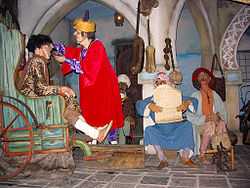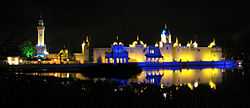Fata Morgana (Efteling)
| Fata Morgana | |||||||||||
|---|---|---|---|---|---|---|---|---|---|---|---|
|
Fata Morgana at night | |||||||||||
| |||||||||||
| General Statistics | |||||||||||
| Type | Dark ride | ||||||||||
| Manufacturer | Intamin | ||||||||||
| Designer | Ton van de Ven, Jan Verhoeven | ||||||||||
| Model | Tow boat ride | ||||||||||
| Speed | 2 km/h (1.2 mph) | ||||||||||
| Capacity | 1800 riders per hour | ||||||||||
| Duration | 8 minutes | ||||||||||
Fata Morgana, the forbidden city, also known as 1001 Arabian Nights (or "1001 nachten" in Dutch) is a dark ride in amusement park Efteling in the Netherlands. It was designed by Ton van de Ven and Jan Verhoeven and opened in 1986.






Features
Fata Morgana is a dark ride/tow boat ride that was opened in 1986. The city is populated by 140 animatronics. The animatronics have been praised by Coaster Kingdom.uk as "exquisite" and "astounding". The animatronics have exaggerated facial features and animated actions to give them their own charismatic "personality". The movements are created on a camshaft and are projected to the animatronics via Bowden cables, which ensure smooth movements.
Fata Morgana is set inside a large building with turquoise and gold domes on the roof. A large tower serves as the entrance to the ride. There is a large square outside the ride with palm trees, fountains and flames. Oase and De Bazaar, two other attractions are located around it.
The violinist Andre Rieu used Fata Morgana Square as a set in one of his concerts, Andre Rieu in Wonderland. The square was covered with brightly coloured mats, and featured camels and belly dancers. Two songs were played in this set, Salome and the Sabre Dance by Aram Khachaturian.
Boarding
The facade of the ride is a huge domed building painted gold and turquoise. Guests enter through a large tower that serves as the entrance to the ride. They then wait on raised platforms above a round canal with a turntable in the middle. Guests are taken down the stairs and onto the turntable, before boarding 16 passenger boats. There is never more than one boat in each scene.
Ride
The boat peels away from the turntable, and goes through a curtain that automatically parts for each boat. The boat goes into a jungle, and guests see the skyline of a distant Arabian city. Snakes hang from branches above the guests' heads, and hiss. They then meet a wizard, who with a wave of his wand, sends them into the city through a set of wooden doors.
First, the boats enter the poor quarter, where beggars call for attention and camels are grazing in the city streets. Next, the riders enter the markets, where they see colourful bazaars and belly dancing. At the end of the scene, two unpleasant looking prisoners yell for attention.
It is at this moment that the guests realise that the forbidden city is dangerous, but a falling gate ensures they cannot turn back. After getting a glimpse of how bad the prisoners are, the wizard appears in front of them and blasts what appears to be a rock wall into an entrance into the next scene.
The guests pass through the harbour and into a harem, where women are lying down or huddling, and tigers roar and paw the ground. The guests pass into the throne room of the pasha, where a party is going strong. The pasha is surrounded by tens of servants, musicians, belly dancers and guests, who all move to the music. The boat penetrates into the pasha's treasury, but the guests also meet a huge giant who isn't happy with intruders. The boat passes through the giant's legs, and then the wizard appears again. With his wand, he points the way, but in a strike of thunder disappears (using the Pepper's Ghost illusion). Then suddenly, the boat seems to tilt and large lasers up above boil the water. After passing through the jungle a second time, the doors then open and the guests find themselves back in the foyer. They leave the boats via the turntable. But the guests are left to wonder; was the whole city real or was it just a Fata Morgana in their own minds?
Total ride time is 8 minutes, capacity of 1800 persons/ hour.
History and details
The attraction is considered to be the link between the old fairy-tale style of Anton Pieck and the newer, more intensive rides.
The opening was planned for 1984, but in order to give more time for the designing team it was postponed to 1986. The original name Fata Medina was changed to Fata Morgana to avoid confusion with the Islamic holy city, though it is more likely that it was a reference to the first completed part of the ride, the Medina quarter- the poor district and central marketplace.
The decorative art was bought in the Moroccan city of Marrakech and the animatronics were dressed by Belgian designer Jeanine Lambrechts.
Underwater rotating disks regulate the transport system provided by the Swiss manafucturer Intamin. The whole transport system was developed by Intamin (as a Tow boat ride).
Total cost, converted from Guilders: € 7 million.
Music
The music for Fata Morgana was composed by composer Ruud Bos, who also wrote the musical themes for Dreamflight, Bird Rok and Villa Volta.
Naturally he chose a Harem style as the base theme for the music. More specifically, the beginning of the ride is linked by orchestral music to the dreamy, mideastern music with flutes and violins of the market, the first setting of the attraction. The music gets darker when the ride passes the prison part. A slow melody sets in upon entering the harbor but is extended with instruments like violins, gongs and a percussion. The musical climax comes when the ride ends in the final scene of the throneroom.
There are five compositions:
- The Harem
- The Harbor
- The Market Place
- The Eastern Jails
- The Jungle
30 amplifiers and 150 loudspeakers generate a total of 8000 Watt.
References
| Wikimedia Commons has media related to Fata Morgana. |
Coordinates: 51°38′49″N 5°02′44″E / 51.64694°N 5.04556°E
| ||||||||||||||||||||||
